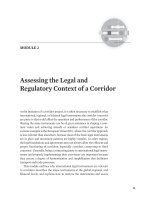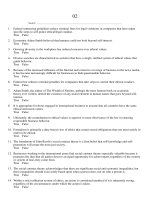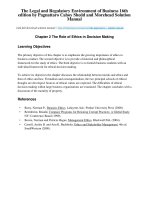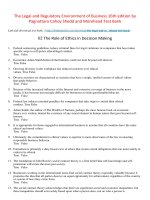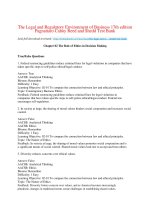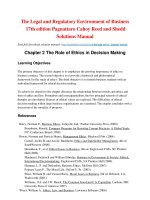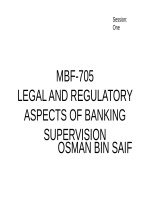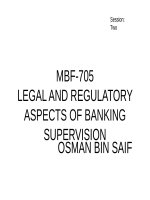Lecture Legal and regulatory aspects of banking supervision – Chapter 13
Bạn đang xem bản rút gọn của tài liệu. Xem và tải ngay bản đầy đủ của tài liệu tại đây (76.97 KB, 50 trang )
Session:
THIRTEEN
MBF-705
LEGAL AND REGULATORY
ASPECTS OF BANKING
SUPERVISION
OSMAN BIN SAIF
Summary of previous session
•
•
Governance Structure of State Bank of
Pakistan
Central Board of Directors
–
Members
•
Governor of State Bank of Pakistan
•
Corporate Secretary
•
Committees of the Central Board
–
Audit
2
Summary of previous session
(Contd.)
•
Management Structure
•
Corporate Management Team
•
Other Major Management Committees
•
Subsidiaries of State Bank of Pakistan
1.
Banking Services Corporation
2.
National Institute of Banking and Finance
(NIBAF)
3
Agenda of this Session
•
•
•
Core Functions of the State Bank of
Pakistan
Main Responsibilities of the State Bank of
Pakistan.
1.
Regulation of Liquidity
2.
Ensuring the soundness of financial system
3.
Exchange rate management and balance of
payments
Developmental Role of the State4 Bank of
Core Functions of State Bank of
Pakistan
•
•
State Bank of Pakistan is the Central Bank
of the country.
While its constitution, as originally laid
down in the State Bank of Pakistan Order
1948, remained basically unchanged until
1st January 1974 when the Bank was
nationalized, the scope of its functions
was considerably enlarged.
5
Core Functions of State Bank of
Pakistan (Contd.)
•
The State Bank of Pakistan Act 1956, with
subsequent amendments, forms the basis
of its operations today.
6
Core Functions of State Bank of
Pakistan (Contd.)
•
Under the State Bank of Pakistan Order
1948, the Bank was charged with the duty
to
"regulate the issue of Bank notes and
keeping of reserves with a view to securing
monetary stability in Pakistan and generally
to operate the currency and credit system of
the country to its advantage".
7
Core Functions of State Bank of
Pakistan (Contd.)
•
The scope of the Bank’s operations was
considerably widened in the State Bank of
Pakistan Act 1956, which required the
Bank to "regulate the monetary and credit
system of Pakistan and to foster its growth
in the best national interest with a view to
securing monetary stability and fuller
utilization of the country’s productive
resources".
8
Core Functions of State Bank of
Pakistan (Contd.)
•
•
Under financial sector reforms, the State
Bank of Pakistan was granted autonomy
in February 1994.
On 21st January, 1997, this autonomy was
further strengthened by issuing three
Amendment Ordinances (which were
approved by the Parliament in May, 1997)
namely,
–
–
State Bank of Pakistan Act, 1956,
9
Core Functions of State Bank of
Pakistan (Contd.)
•
The changes in the State Bank Act gave
full and exclusive authority to the State
Bank to regulate the banking sector, to
conduct an independent monetary policy
and to set limit on government borrowings
from the State Bank of Pakistan.
10
Core Functions of State Bank of
Pakistan (Contd.)
•
The amendments in Banks Nationalization
Act abolished the Pakistan Banking
Council (an institution established to look
after the affairs of NCBs) and
institutionalized the process of
appointment of the Chief Executives and
Boards of the nationalized commercial
banks (NCBs) and development finance
institutions (DFIs), with the Sate Bank
having a role in their appointment
and
11
Core Functions of State Bank of
Pakistan (Contd.)
•
The amendments also increased the
autonomy and accountability of the Chief
Executives and the Boards of Directors of
banks and DFIs.
12
Core Functions of State Bank of
Pakistan (Contd.)
•
•
Like a Central Bank in any developing
country, State Bank of Pakistan performs
both the traditional and developmental
functions to achieve macro-economic
goals.
The traditional functions, which are
generally performed by central banks
almost all over the world, may be
classified into two groups:
13
Classification of Core Functions
•
(a) the primary functions including issue of
notes, regulation and supervision of the
financial system, bankers’ bank, lender of
the last resort, banker to Government, and
conduct of monetary policy, and
14
Classification of Core Functions
(Contd.)
•
(b) the secondary functions including the
agency functions like management of
public debt, management of foreign
exchange, etc., and other functions like
advising the government on policy matters
and maintaining close relationships with
international financial institutions.
15
Classification of Core Functions
(Contd.)
•
The non-traditional or promotional
functions, performed by the State Bank
include development of financial
framework, institutionalization of savings
and investment, provision of training
facilities to bankers, and provision of credit
to priority sectors.
16
Classification of Core Functions
(Contd.)
•
The State Bank also has been playing an
active part in the process of islamization of
the banking system.
17
Main Responsibilities of The
State Bank
•
The main functions and responsibilities of
the State Bank can be broadly categorized
as under.
1.
Regulation of Liquidity
2.
Ensuring the soundness of financial system
3.
Exchange rate management and balance of
payments
18
REGULATION OF LIQUIDITY
•
Being the Central Bank of the country,
State Bank of Pakistan has been
entrusted with the responsibility to
formulate and conduct monetary and
credit policy in a manner consistent with
the Government’s targets for growth and
inflation and the recommendations of the
Monetary and Fiscal Policies Coordination Board with respect to macroeconomic policy objectives.
19
REGULATION OF LIQUIDITY
(Contd.)
•
The basic objective underlying its
functions is two-fold i.e. the maintenance
of monetary stability, thereby leading
towards the stability in the domestic
prices, as well as the promotion of
economic growth.
20
REGULATION OF LIQUIDITY
(Contd.)
•
To regulate the volume and the direction of
flow of credit to different uses and sectors,
the Bank makes use of both direct and
indirect instruments of monetary
management. Until recently, the monetary
and credit scenario was characterized by
acute segmentation of credit markets with
all the attendant distortions.
21
REGULATION OF LIQUIDITY
(Contd.)
•
Pakistan embarked upon a program of
financial sector reforms in the late 1980s.
A number of fundamental changes have
since been made in the conduct of
monetary management which essentially
marked a departure from administrative
controls and quantitative restrictions to
market-based monetary management.
22
REGULATION OF LIQUIDITY
(Contd.)
•
•
A reserve money management
programme has been developed. In terms
of the programme, the intermediate target
would be achieved by observing the
desired path of reserve money - the
operating target.
While use in now being made of such
indirect instruments of control as cash
reserve ratio and liquidity ratio, the
program’s reliance is mainly on open
23
ENSURING THE SOUNDNESS
OF FINANCIAL SYSTEM:
State Bank performs its role of ensuring the
soundness of financial system by exercising
the following:
1.
2.
3.
Regulation and supervision
Exchange rate management and balance
of payments
Developmental role of state bank
24
•
ENSURING THE SOUNDNESS
OF FINANCIAL SYSTEM:
One of the fundamental
responsibilities of
(Contd.)
the State Bank is regulation and
supervision of the financial system to
ensure its soundness and stability as well
as to protect the interests of depositors.
•
The rapid advancement in information
technology, together with growing
complexities of modern banking
operations, has made the supervisory role
more difficult and challenging. 25
